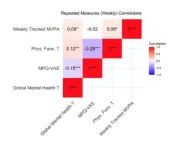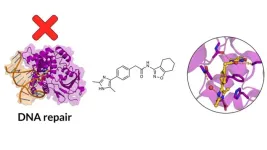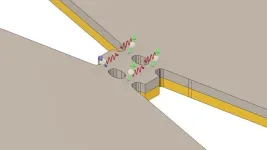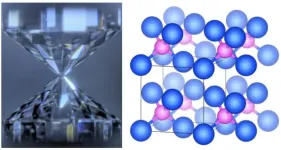(Press-News.org) Colorectal cancer, the second most common cause of cancer-related death, affects almost 2 million people worldwide every year. It is mainly treated with chemotherapy, but its effectiveness decreases over time due to the progressive resistance of tumor cells. A team from the University of Geneva (UNIGE) has identified specific alterations in certain lipids in cancer cells resistant to chemotherapy. These lipid signatures could serve as prognostic markers for understanding resistance to treatment and pave the way for personalized, targeted strategies to restore drug sensitivity. This work is published in the International Journal of Molecular Sciences.
Every year, almost 2 million people are diagnosed with colorectal cancer worldwide. By 2040, this number could exceed 3 million, which could increase the number of deaths from 700,000 to 1.6 million. This poor prognosis results from the disease often being discovered late, as symptoms do not appear immediately.
Its treatment, at an advanced stage, is mainly based on a combination of chemotherapies called FOLFOXIRI. It has significant side effects, and its effectiveness varies greatly from one individual to another. Above all, cells that make up tumors gradually become insensitive to it, eventually developing resistance. Preventing or overcoming this process is one of the major challenges in oncology research.
A lipid “signature”
The team led by Prof. Patrycja Nowak-Sliwinska, Associate Professor in the School of Pharmaceutical Sciences at the UNIGE Faculty of Science, has carried out several research projects on this issue. After developing drug combinations (2022) that could potentially ‘‘bypass’’ this resistance, and then artificial tumors to test the effectiveness of treatments (2023), the team demonstrated that cancer cells that have become resistant to FOLFOXIRI display specific changes in certain lipids.
‘‘The identification of altered lipid species could serve as potential prognostic markers of chemotherapy resistance. Additionally, understanding these changes may help to develop new treatment strategies to overcome this resistance, and may play a crucial role in restoring drug sensitivity,’’ explains Dr. George M. Ramzy, Research and Teaching Fellow in the School of Pharmaceutical Sciences at the UNIGE Faculty of Science, and first author of the study.
To achieve these promising results, Prof. Nowak-Sliwinska’s team collaborated with the group headed by Serge Rudaz, Full Professor in the School of Pharmaceutical Sciences. Four cancer cell lines from four patients were studied, each with a different genetic profile. In the laboratory, some of these cells were exposed to FOLFOXIRI for up to 60 weeks, the time required for them to develop resistance to the treatment, as observed in clinical settings. Another part of the sample was left untreated. ‘‘We then analyzed and compared the lipid profile, known as the ‘‘lipidome’’, of the cancer cells that were resistant to this chemotherapy with those that had not received any treatment,’’ explains Prof. Patrycja Nowak-Sliwinska, who led the study.
Using an “in-house” algorithm
‘‘Untargeted lipid profiling was performed using liquid chromatography coupled with high-resolution mass spectrometry to distinguish between the different lipid subspecies,’’ explains Dr. Isabel Meister, Research and Teaching Fellow in the School of Pharmaceutical Sciences at the UNIGE Faculty of Science and co-author of the study.
For data analysis and interpretation of the different lipid alterations, the team used a specially designed algorithm to differentiate common and specific variations between the lipidomes of cells sensitive and resistant to FOLFOXIRI. ‘‘The high dimensionality of the data and the various sources of variability in the lipidomic signatures were efficiently handled using an approach that combines experimental design and factor analysis,’’ explains Dr Julien Boccard, Senior Lecturer in the School of Pharmaceutical Sciences at the UNIGE Faculty of Science.
Inter-individual variation
In a first cell line, this method revealed that resistance was associated with an increase in triglycerides and cholesterol esters. In the other three lines, it was associated with an increase in phospholipids. ‘‘These differences can be explained by the different genetic profiles of each individual. Every patient is different. This explains the variability in the effectiveness of treatments, and therefore the importance of a personalized approach’’ explains George M. Ramzy.
While these results pave the way for personalized treatment strategies or treatments aimed at restoring sensitivity to chemotherapy, they are not yet applicable in clinical settings. Before taking this step, they will have to be tested directly on freshly isolated tumor samples, rather than laboratory cell lines.
END
Colorectal cancer: Lipids can predict treatment efficacy
A UNIGE team has identified lipid signatures associated with chemotherapy-resistant cells, paving the way for new treatment strategies.
2025-02-26
ELSE PRESS RELEASES FROM THIS DATE:
Physical activity boosts mental health in women with chronic pelvic pain disorders
2025-02-26
New York, NY [February 26, 2025]— A new Mount Sinai study provides compelling evidence that exercise can significantly help the mental well-being of millions of women living with chronic pelvic pain disorders (CPPDs), such as endometriosis and uterine fibroids.
The researchers at the Icahn School of Medicine at Mount Sinai found that activities like brisk walking or aerobic exercise can lead to measurable improvements in mental well-being, regardless of pain levels or history of anxiety or depressive disorders. Their findings were reported in the February 26 online issue of the Journal of Pain Research.
CPPDs affect millions of women worldwide, leading to increased health care ...
New method searches through 10 sextillion drug molecules
2025-02-26
A recent study shows that computer algorithms can be used to find molecules that can be developed into anti-inflammatory drugs. In the article, the researchers also describe how the same strategy can be used to search through 10 sextillion alternatives to identify the best drug candidate.
One of the biggest challenges in drug development is finding the right candidates among the vast number of possible molecules. A new study published in Nature Communications shows that it is possible to identify drug molecules by modelling them using computer algorithms.
“We use the computer models to search through databases containing billions of molecules. This method will be able ...
Breakthrough in the development of a new low-cost computer
2025-02-26
A low-energy challenger to the quantum computer that also works at room temperature may be the result of research at the University of Gothenburg. The researchers have shown that information can be transmitted using magnetic wave motion in complex networks.
Spintronics explores magnetic phenomena in nano-thin layers of magnetic materials that are exposed to magnetic fields, electric currents and voltages. These external stimuli can also create spin waves, ripples in a material's magnetisation that travel with a specific phase and energy.
The researchers ...
New computer model can predict the length of a household's displacement in any U.S. community after a disaster
2025-02-26
HERNDON, Va., February 25, 2025 -- One of the human impacts of natural hazards is household displacement. Destructive floods, wildfires, earthquakes and hurricanes often force people to leave their homes -- some briefly, others for months or indefinitely.
Most disaster risk assessments, used by insurance companies, government agencies, development banks, and academic researchers to predict the potential future impacts of natural hazards, fail to account for hardships incurred by household displacement. Instead, they focus on direct ...
At your service: How older adults embrace demand-responsive transportation
2025-02-26
In residential areas, where a growing number of older people live, the first- and last-mile mobility between their homes and bus stops has become a social problem. Older adults are encouraged to relinquish their licenses and rely on public transportation. Demand-responsive transport (DRT) has the potential to address this social problem. DRT is a mode of transportation that dispatches on demand to pick up and drop off passengers according to their needs. However, older adults’ lesser acceptance of digital solutions poses a challenge to this new system.
Dr. Haruka Kato, a junior associate professor at Osaka Metropolitan ...
Enhancing lithium-ion battery performance with roll-to-roll compatible flash process technology
2025-02-26
A world-first technology has been developed by introducing a roll-to-roll compatible flash process into secondary battery electrode manufacturing, significantly suppressing the performance degradation of thick electrodes. This breakthrough presents a new possibility of reducing battery costs by minimizing inactive materials and simplifying the manufacturing process while increasing energy density and capacity, making batteries smaller and lighter.
The Korea Institute of Machinery and Materials (President Seog-Hyeon Ryu, hereinafter referred to as KIMM), an institute under the jurisdiction of the Ministry of Science and ICT, has developed an electrode activation technology utilizing an ...
Simulating scientists: New tool for AI-powered scientific discovery
2025-02-26
Named LLM4SD (Large Language Model 4 Scientific Discovery), the new AI system is an interactive Large Language Model (LLM) tool which can carry out basic steps of scientific research i.e. retrieve useful information from literature and develop hypotheses from data analysis. The tool is freely available and open source.
When asked, the system is also able to provide insights to explain its results, a feature that is not available for many current scientific validation tools.
LLM4SD was tested with 58 separate research tasks relating to molecular properties across four different scientific domains: physiology, physical chemistry, biophysics and quantum mechanics.
Lead ...
Helium in the Earth's core
2025-02-26
Researchers from Japan and Taiwan reveal for the first time that helium, usually considered chemically inert, can bond with iron under high pressures. They used a laser-heated diamond anvil cell to find this, and the discovery suggests there could be huge amounts of helium in the Earth’s core. This could challenge long-standing ideas about the planet’s internal structure and history, and may even reveal details of the nebula our solar system coalesced from.
If you’ve ever seen a volcanic eruption and wondered what might be coming ...
Study: First female runner could soon break the 4-minute-mile barrier
2025-02-26
On May 6, 1954, Roger Bannister pushed through the finishing tape at Iffley Road track in Oxford, England, and collapsed into the arms of friends after becoming the first human to run a mile in less than four minutes.
“It was the running equivalent to summiting Mount Everest for the first time,” said University of Colorado Boulder Integrative Physiology Professor Rodger Kram. “Prior to Bannister, it was considered impossible—beyond the limits of human physiology.”
Seven decades later, a female runner has yet to follow ...
High dietary fish intake may slow disability progression in MS
2025-02-26
A high dietary intake of lean and oily fish may slow the progression of disability in people with multiple sclerosis (MS), suggests a comparative population based study, published online in the Journal of Neurology Neurosurgery & Psychiatry.
The anti-inflammatory and neuroprotective properties of the nutrients found in fish may be key, say the researchers, who add that their findings underscore the potential importance of diet in managing the disease.
Emerging evidence indicates that diet may have a role in the development of inflammatory diseases, including MS, explain the researchers.
While previously published research has linked fish ...
LAST 30 PRESS RELEASES:
Making lighter work of calculating fluid and heat flow
Normalizing blood sugar can halve heart attack risk
Lowering blood sugar cuts heart attack risk in people with prediabetes
Study links genetic variants to risk of blinding eye disease in premature infants
Non-opioid ‘pain sponge’ therapy halts cartilage degeneration and relieves chronic pain
AI can pick up cultural values by mimicking how kids learn
China’s ecological redlines offer fast track to 30 x 30 global conservation goal
Invisible indoor threats: emerging household contaminants and their growing risks to human health
Adding antibody treatment to chemo boosts outcomes for children with rare cancer
Germline pathogenic variants among women without a history of breast cancer
Tanning beds triple melanoma risk, potentially causing broad DNA damage
Unique bond identified as key to viral infection speed
Indoor tanning makes youthful skin much older on a genetic level
Mouse model sheds new light on the causes and potential solutions to human GI problems linked to muscular dystrophy
The Journal of Nuclear Medicine ahead-of-print tip sheet: December 12, 2025
Smarter tools for peering into the microscopic world
Applications open for funding to conduct research in the Kinsey Institute archives
Global measure underestimates the severity of food insecurity
Child survivors of critical illness are missing out on timely follow up care
Risk-based vs annual breast cancer screening / the WISDOM randomized clinical trial
University of Toronto launches Electric Vehicle Innovation Ontario to accelerate advanced EV technologies and build Canada’s innovation advantage
Early relapse predicts poor outcomes in aggressive blood cancer
American College of Lifestyle Medicine applauds two CMS models aligned with lifestyle medicine practice and reimbursement
Clinical trial finds cannabis use not a barrier to quitting nicotine vaping
Supplemental nutrition assistance program policies and food insecurity
Switching immune cells to “night mode” could limit damage after a heart attack, study suggests
URI-based Global RIghts Project report spotlights continued troubling trends in worldwide inhumane treatment
Neutrophils are less aggressive at night, explaining why nighttime heart attacks cause less damage than daytime events
Menopausal hormone therapy may not pose breast cancer risk for women with BRCA mutations
Mobile health tool may improve quality of life for adolescent and young adult breast cancer survivors
[Press-News.org] Colorectal cancer: Lipids can predict treatment efficacyA UNIGE team has identified lipid signatures associated with chemotherapy-resistant cells, paving the way for new treatment strategies.





